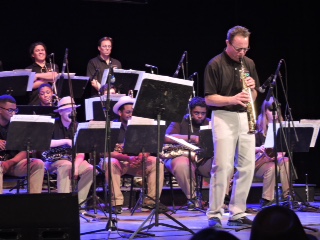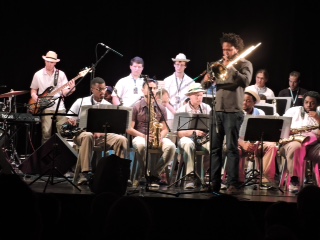
Cubans, Norwegians join performance during historic Havana Jazz Festival trip
by Alan Hoskins
Havana, Cuba – On hand for the historic warming of U.S. and Cuban relations, the Kansas City Kansas Community College Blue Devil Jazz Band took the warming to another level.
Arriving in this Cuban capital for their performances in the Havana Jazz Festival Nov. 16, the Jazz Band entourage arose the next morning to the news that the U.S. and Cuba had exchanged political prisoners and opened the door to sweeping changes in U.S.-Cuban policy that has existed since 1961.
“It was a day I’ll never forget,” said Mirelys Gonzalez, the Cuban tour guide. As only fate would have it, Gonzalez was explaining the importance in Cuban history of a historic bell tower during a walking tour of Havana when the bell began to ring.
“That’s the first time in all my years (43) that I’ve heard the bell ring,” she said of the historic moment.
The Jazz Band stole the show in its opening performance in the Jazz Festival. Cubans danced in the aisle and the band drew a lengthy standing ovation from a crowd of upwards of 500 that nearly filled a performance center.
Then in its final performance, Director Jim Mair invited members of Cuban and Norwegian bands to join the KCKCC band in playing improvisational solos in a pair of jazz classics, an offer that was quickly accepted by a half-dozen musicians from both the other bands.
Appropriately, the band finished with its rendition of “Kansas City” featuring vocalist Cherilee Walker, dean of KCKCC Humanities and Social Sciences.
“Having musicians from other countries join us was my big highlight,” Mair said. “I literally had tears in my eyes seeing all the smiles and the joy. The Cuban trombone player played the ‘Star Spangled Banner’ during his solo and then smiled at the band.”
Mair picked two songs in which he knew the Cuban and Norwegian musicians could perform after hearing them and joining them in jam sessions.
“We all spoke different languages but when it came to jazz, all were playing a common language,” Mair said. “Jazz is a great unifier and the epitome of democracy.”
“Playing in front of all those people was incredible, especially with people fighting to take pictures of us,” said Matt Ogilvie, sophomore trombonist from Basehor-Linwood. While unable to see the photographers and the standing ovation because of blindness, guitarist Mackie Jones was equally elated.
“The concert was the best and they said all the people were taking our pictures,” Jones said. Recognition carried to the streets. “People would recognize us and say great concert,” said Ian Corbett, one of the band’s featured saxophone soloists.
“I thought the band’s performance was top notch,” said Marlin Cooper, one of nearly 20 community members on the trip and 27-year jazz band instructor at KCKCC. “The interaction with other countries was great. Jim inviting others was a terrific idea.”
While the Jazz Festival was the focus of the six-day trip, the Jazz Band got an outstanding educational introduction to a culture far different than that of the U.S. Havana is unlike any other city in the world. A literal living museum of antique cars, hundreds and hundreds of American-made cars, mostly from the 1950s and beyond, filled the streets. Unable to import cars from the U.S. since Fidel Castro turned Cuba into a Communist country in 1961, Cuban ingenuity in keeping the antiques running borders on the unbelievable.
Used mainly as taxis, a ride in a 1956 Ford Fairlane convertible on a near-perfect evening was but one of countless highlights. Also offered as a means of transportation are “Coco Taxis,” football helmet-shaped motorized tricycles that hold up to three passengers and can zip in and out of traffic and along the Malecon, a 5-mile promenade fronting the Gulf of Mexico. On a Saturday night, the oceanfront promenade was almost shoulder to shoulder with people enjoying conversation and the balmy breezes in 70 degree temperatures.
Music and art are huge in Cuba and the students got introductions to both. One of the highlights for many was a jazz ballet featuring eight dancers in a multi-media performance using overhead cameras to create unique angles and illusions.
Students also visited Havana’s Museum of Fine Arts and the leading art academy for music, modern dance, drama and visual arts but because of a performance rehearsal missed on one the highlights of the community members on the trip, a stop at a dance studio in one of Havana’s most humble neighborhoods where nine senior citizens 65 through 87 years put on a dazzling exhibition. One 87-year-old tap-danced, all danced with the agility and enthusiasm of the days of jitterbugging and then invited our group to learn the salsa and rhumba.
Music is everywhere. You can’t go to a restaurant without musicians performing and some of the KCKCC students sat in on hotel performances. Food was excellent, especially if you like black beans and rice (I didn’t), and certainly reasonably price, much less than most foreign countries. There are two kinds of restaurants, ones owned by the government and Paladares, which have government-issued licenses to allow Cuban homeowners to serve home-cooked meals to tourists inside their homes. We ate in both including one in which Castro occasionally made one of his rare public visits. While popular among most Cubans, we were told countless attempts had been made on Castro’s life.
A don’t miss highlight was a visit to the hilltop villa of Finca Vigni, where Ernest Hemingway lived from 1939-60 and authored “The Old Man and the Sea” which earned a Nobel Peace Prize. In addition to various manuscripts, countless photos, priceless art collection and a 9,000 book library, the home also has Hemingway’s fishing tackle and the boat depicted in his famed novel.
No trip to Cuba would be complete either without a chance to swim or at least wade on the many sandy beaches or a trip into the spectacular Vinales Valley, which included visit a working tobacco farm; a boat trip through a large subterranean cave; and lunch at a restaurant at the foot of a mogote (mountain) featuring a huge colorful mural.
In summary, Cubans are friendly and seemingly like Americans (if not, we didn’t see it). Lifting of the embargo on tourism from the U.S. would be hugely popular and a tremendous boost to the Cuban economy. Countless buildings fronting the Gulf of Mexico are abandoned and in disrepair, an unparalleled opportunity for investors seeking oceanfront views.
Whether Cuban cigars and rum can be brought into the U.S. remains up in the air. Community members were told yes and returned with both but others were stopped by customs agents in Dallas who apparently had not got the message and confiscated not only cigars and rum but some Cuban art works.
Alan Hoskins is the sports information director for KCKCC.

